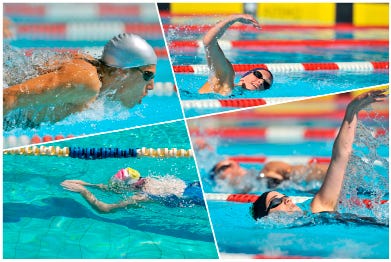by Coach Tom

For the next bit my foolish musings will be modifications or adaptions of Sheila Taormina”s book, Swim Speed Strokes. I found this to be an interesting analysis of technique and the science of swimming. The strength of the book is in its photos which show extraordinary swimmers in action. Unfortunately, I can’t reproduce all those photos for you but some content does translate into words and I will give that a try.
One concept that I have used often but never really stopped to understand is that of “long axis” strokes-freestyle and backstroke- and “short axis” strokes-breaststroke and butterfly. The first of many definitions of axis in my dictionary is: “The straight line about which a body or geometric object rotates or may be conceived to rotate”. In other words, the axis does not move (at least in terms of rotation) and the other parts of the structure move in a rotational manner around it.
In short axis strokes the imaginary line runs from one side of the hips to the other. The hips remain in the same position near the surface of the water during all phases of the stroke as the body oscillates in rhythm on the short axis. This rotation around a fixed point requires both flexibility and core strength but allows for smooth (laminar) flow of water past torso, hips and upper legs.
For long axis strokes the imaginary line runs the length of the body, from the top of the head down through the navel. The challenge is to balance the body side to side. The body must rotate allowing the arm to reach forward as we extend into the catch phase and the opposite hip rotates up as that side finishes the stroke with a resultant slight twisting of the core. This stable core allows for effective movement of the limbs without inefficient sideways movements like the leg crossing on kick, a habit I just can’t seem to break.

